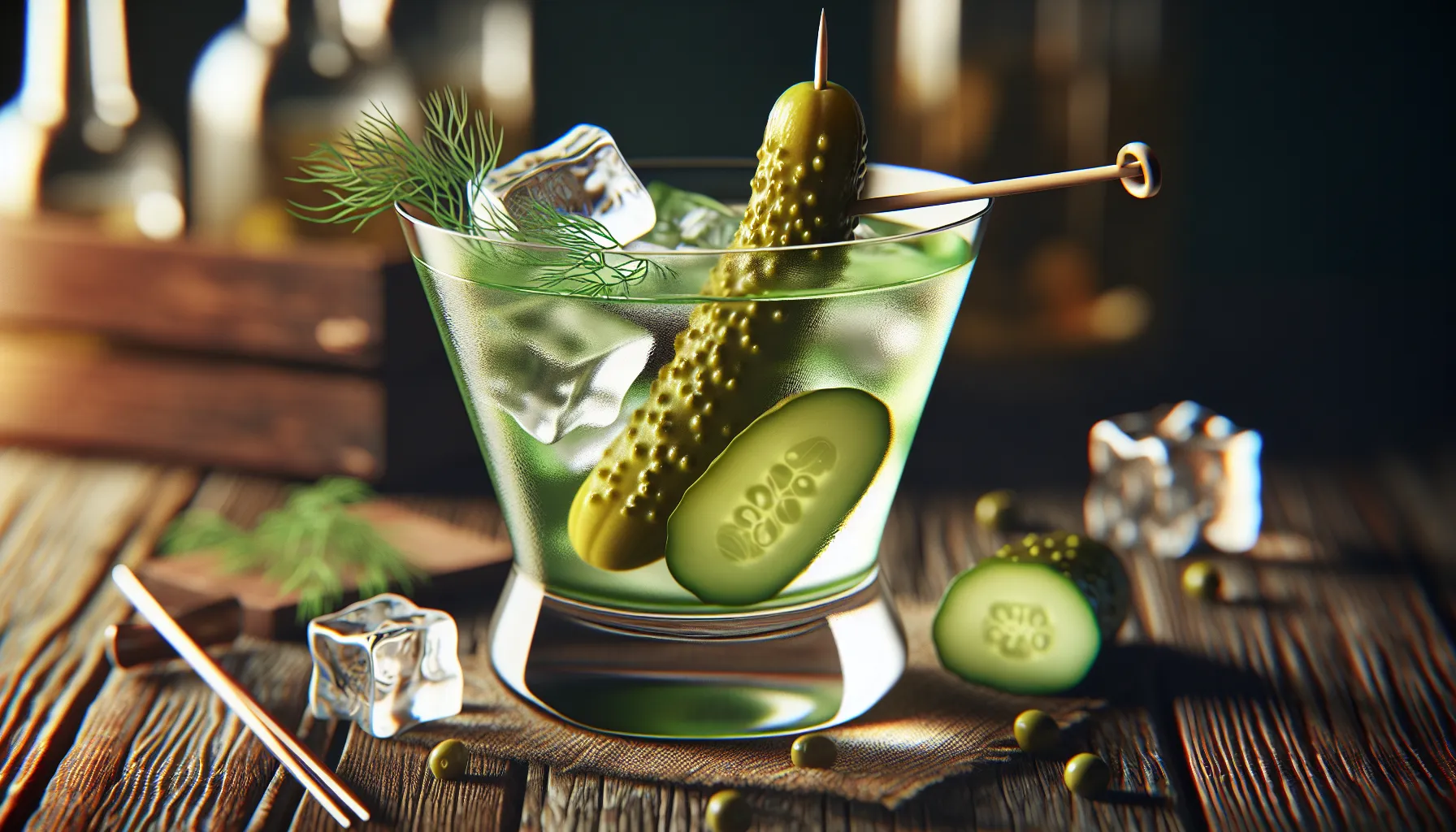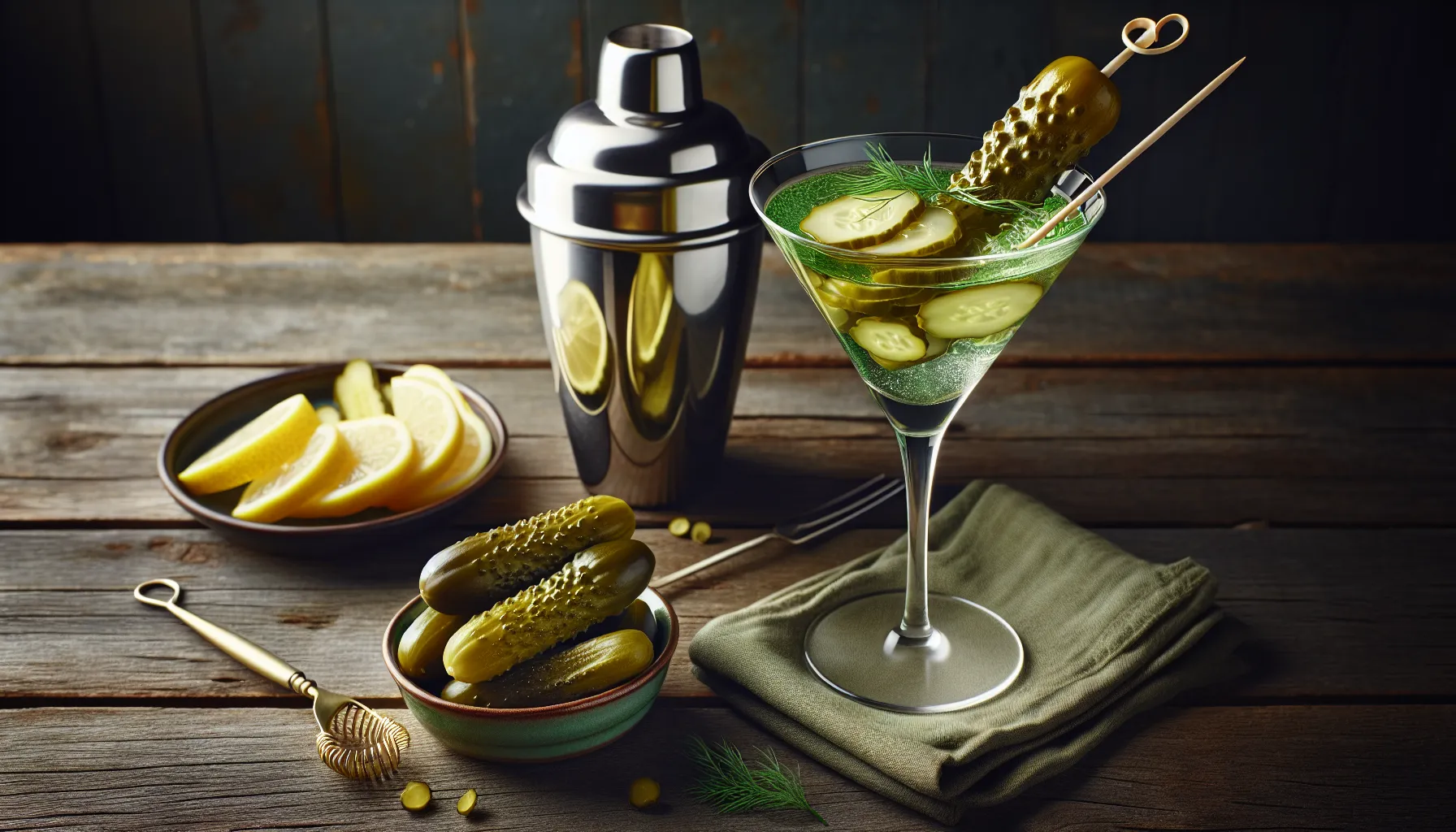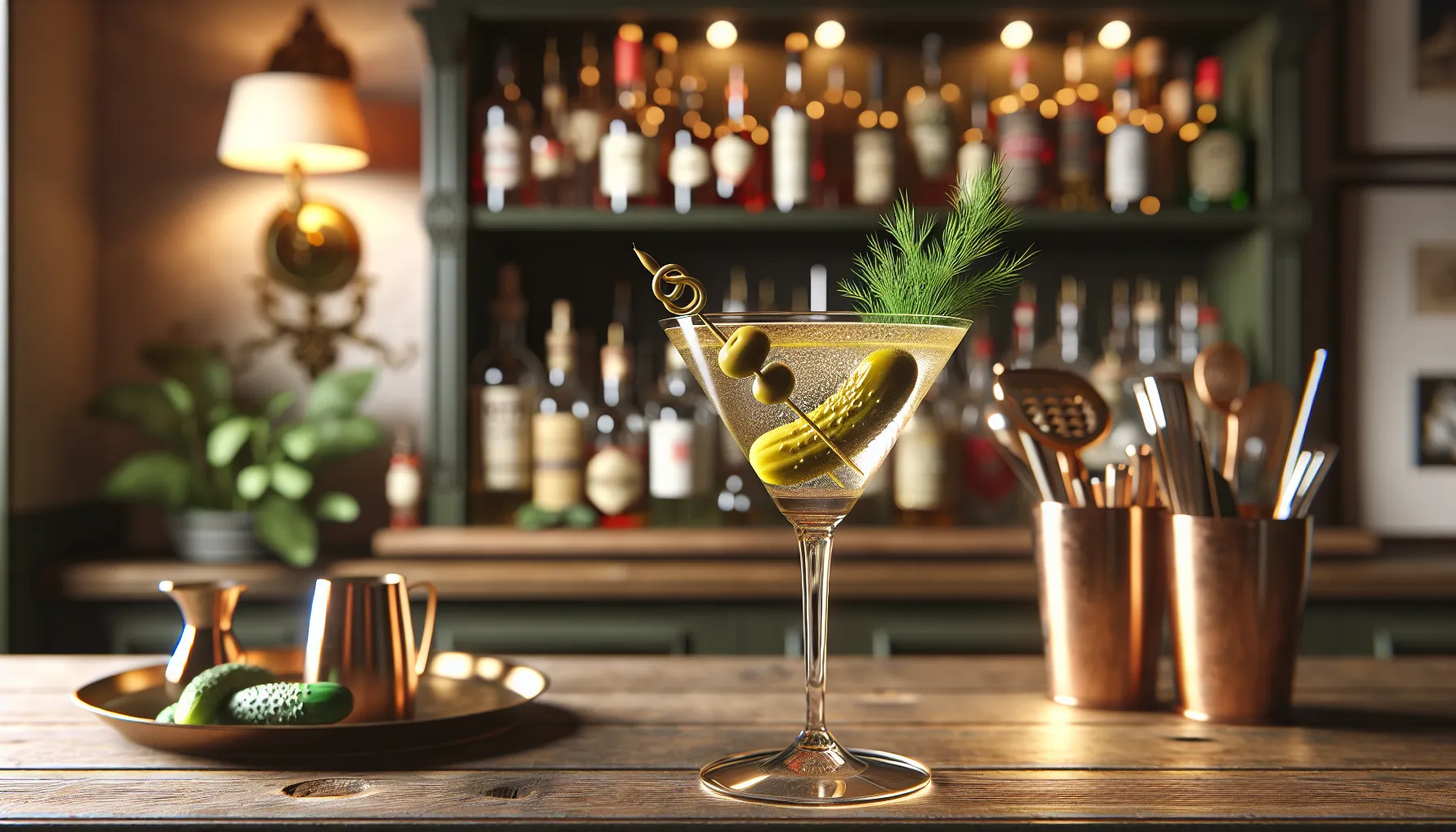Key Takeaways
- A pickle martini blends gin or vodka, dry vermouth, and pickle brine for a savory, briny twist on the classic martini; start with 2 oz spirit, 0.5 oz vermouth, and 0.25–0.75 oz brine.
- Choose gin for herbal lift with dill brine or vodka for a clean canvas with sweeter bread-and-butter brines; adjust brine in 0.1 oz steps to dial dirtiness.
- Stir over dense ice for 20–30 seconds, fine‑strain for clarity, and serve in a well‑chilled coupe or Nick and Nora; express a lemon peel for brightness.
- Use quality ingredients: fresh, refrigerated dry vermouth; clear, flavorful pickle brine (dill, spicy, or bread-and-butter); and crisp garnishes like cornichons, dill spears, or caperberries.
- Try variations like spicy pickle martinis (chili tincture, jalapeño, or kimchi brine) and pair with salty-fatty snacks—oysters, smoked salmon, fried bites, sharp cheeses—for balance.
- Avoid common mistakes: shaking (clouds texture), stale vermouth, mismatched brine and base spirit, over-salting with rims or excessive garnishes, and unmeasured brine.
I love a cocktail that surprises on the first sip. The pickle martini does exactly that with briny snap and crisp spirit. It sounds wild yet it feels instantly right.
I first tried one on a lazy Sunday and I’ve chased that bright tang ever since. It turns the classic martini into a playful sip with attitude. If you crave savory twists this drink will find you fast.
I’ll share what makes it work and how to balance the brine with botanicals. I’ll keep it simple so you can shake one tonight. Grab your favorite jar of pickles and let’s dive in.
What Is A Pickle Martini?
A pickle martini is a savory martini riff that blends spirit, vermouth, and pickle brine for briny balance. I base mine on the Dry Martini template from the International Bartenders Association for structure, then I swap olive brine for pickle brine for flavor clarity (IBA, https://iba-world.com/cocktails/dry-martini/). I use brine from vinegar pickles, since the acetic acid and salt create the signature tang and snap (NCHFP, University of Georgia, https://nchfp.uga.edu/how/can_06/pickled_06).
- Use gin or vodka for the base, use gin for herbal lift or vodka for neutral weight.
- Use dry vermouth for dryness, use 0.25–0.5 oz for a lean profile.
- Use dill pickle brine for classic deli notes, use bread-and-butter brine for sweeter balance, use spicy brine for heat.
- Use a cornichon, a dill spear, or a pickle chip for garnish.
- Use a mixing glass and ice for texture, use a fine strain for a clean surface.
- Use a chilled coupe or Nick and Nora for service, use a heavy rocks glass over one large cube if you prefer dilution.
Ratios I use for a pickle martini
| Style | Spirit, type | Spirit, oz | Dry vermouth, oz | Pickle brine, oz | Garnish |
|---|---|---|---|---|---|
| Classic-dry | Gin | 2.5 | 0.5 | 0.25 | Cornichon on pick |
| Brinier-vodka | Vodka | 2.0 | 0.5 | 0.5 | Dill chip |
| Dirty-dill | Gin | 2.0 | 0.25 | 0.75 | Dill spear |
I stir with ice for 20–30 seconds for dilution, if I want a silky texture. I express a lemon peel lightly over the glass for brightness, if the brine tastes heavy. I double strain to catch seeds and pepper flakes, if the pickle jar carries aromatics.
Ingredients That Make A Great Pickle Martini

Ingredients define a great pickle martini.
- Base spirit: Gin adds herbal lift or vodka keeps the pickle martini clean so I pick a London Dry gin for bold juniper or a clean vodka for neutrality, examples Beefeater Tanqueray Plymouth or Wheatley [Source: Difford’s Guide].
- Dry vermouth: Dry vermouth dries and lengthens the pickle martini so I reach for a fresh bottle at 15 to 18 percent ABV stored cold after opening, examples Noilly Prat Dolin Martini Extra Dry [Source: EU Reg 251 2014].
- Pickle brine: Pickle brine provides salinity and acid for the pickle martini so I match brine style to my spirit choice, examples dill garlic or bread and butter brines with 2 to 5 percent salt for quick pickles [Source: Serious Eats].
- Ice: Ice drives dilution and chill in a pickle martini so I use large clear cubes to hit smooth texture without excess water [Source: Liquid Intelligence].
- Garnish: Garnish extends aroma in a pickle martini so I skewer crisp items that echo the brine, examples cornichons dill spears cocktail onions or peppercorns [Source: Difford’s Guide].
- Bitters: Bitters sharpen edges in a pickle martini so I deploy a small dash to link botanicals and brine, examples celery bitters orange bitters or savory saline bitters [Source: Imbibe Magazine].
- Citrus oil: Citrus oil brightens a pickle martini so I express a thin lemon peel over the glass then discard to avoid sweet pith notes [Source: Serious Eats].
Ingredient specs
| Component | Key spec | Typical range | Source |
|---|---|---|---|
| Gin or vodka | Bottled strength | 40–47% ABV | Difford’s Guide |
| Dry vermouth | Bottled strength | 15–18% ABV | EU Reg 251 2014 |
| Quick pickle brine | Salt by weight | 2–5% NaCl | Serious Eats |
| Stirred dilution | Water added during stir | 20–25% by volume | Liquid Intelligence |
Practical pairing notes
- Gin pairing: Juniper heavy gin matches dill pickle brine and garlic brine best while citrus forward gin matches bread and butter brine best.
- Vermouth pairing: Bone dry vermouth fits high salt brine while floral vermouth fits sweeter brine.
- Brine clarity: Fine straining brine removes seeds and pepper flakes that cloud a pickle martini while unfiltered brine adds rustic texture.
- Salinity control: Half brine half water in the measure softens aggressive brines while full strength brine suits robust gins.
How To Make A Pickle Martini At Home

I mix a crisp pickle martini with cold tools and clean ice. I match the brine style to the base spirit for balance.
Classic Recipe
I build this recipe on the Dry Martini template from the IBA, then I swap olive brine for pickle brine for clarity (International Bartenders Association, https://iba-world.com).
- Measure 2 oz gin or vodka, 0.5 oz dry vermouth, 0.5 oz pickle brine.
- Add all liquids to a mixing glass with large cubes.
- Stir for 20 to 30 seconds until very cold.
- Strain into a chilled coupe or Nick and Nora.
- Express a lemon peel over the surface, if you want brightness.
- Garnish with a cornichon or a dill spear.
| Style | Base spirit | Dry vermouth | Pickle brine | Stir time | Glass |
|---|---|---|---|---|---|
| Classic Dirty | 2 oz | 0.5 oz | 0.5 oz | 20–30 s | Coupe or N&N |
| Drier Profile | 2 oz | 0.75 oz | 0.25 oz | 20–30 s | Coupe or N&N |
| Brinier Profile | 2 oz | 0.25 oz | 0.75 oz | 20–30 s | Coupe or N&N |
Dirty Vs. Extra Dirty
I anchor the pickle martini brine level to texture and salinity.
| Dirtiness level | Gin or vodka | Dry vermouth | Pickle brine | Salinity note |
|---|---|---|---|---|
| Dirty | 2 oz | 0.5 oz | 0.5 oz | Balanced salt |
| Extra Dirty | 2 oz | 0.25 oz | 0.75 oz | High salt |
- Choose Dirty for a clean martini line, if you want crisp botanicals.
- Choose Extra Dirty for a savory martini push, if you want brine forward impact.
- Adjust 0.1 oz at a time, if your brine tastes stronger or weaker.
Garnish Options
I use garnishes to echo the pickle martini brine.
- Use a dill spear for herbal snap, if the brine is dill based.
- Use cornichons for bright acid, if the brine is tarragon or wine vinegar based.
- Use pickled onion for a Gibson nod, if you want soft allium.
- Use caperberries for saline pop, if you want brine plus floral notes.
- Use a lemon twist for citrus lift, if the drink tastes dense.
- Use a chili pepper slice for heat, if the brine is spicy.
Best Pickles And Brines To Use

Pickle martini flavor hinges on brine style and aroma. I match brine character to spirit, then I tune salt and acid.
Dill Vs. Bread-And-Butter
Dill pickles drive a classic pickle martini. I reach for garlicky dill brine with fresh dill, black pepper, and mustard seed. I pair dill brine with London Dry gin for herbal lift, or I use citrus oil to brighten. I garnish with a dill spear, a cornichon, or a caper berry for snap.
Bread-and-butter pickles create a sweeter pickle martini. I use vodka for a clean frame, or I add dry vermouth to pull back sweetness. I add a lemon twist for freshness, or I add 1 dash celery bitters for structure. I garnish with a thin pickle chip, or I add a skewer with onion to echo the sweet-sour profile.
- Choose dill, choose savory clarity, choose gin, choose citrus oil, choose briny garnish.
- Choose bread-and-butter, choose soft sweetness, choose vodka, choose vermouth, choose crisp garnish.
Store-Bought Vs. Homemade Brine
Store-bought brine offers consistency for a pickle martini. I favor brands that list distilled vinegar, water, salt, dill, garlic, and spices. I avoid brines with artificial sweeteners, dyes, or heavy stabilizers. I taste first, then I dose brine in 0.25 oz steps.
Homemade brine offers control for a pickle martini. I use vinegar at 5% acidity for quick pickles, per USDA guidance [USDA Complete Guide to Home Canning]. I use 2–3.5% salt by weight for fermented brines, per the National Center for Home Food Preservation [NCHFP].
| Brine type | Target acidity or salt | Key components | Best spirit match | Pickle martini notes |
|---|---|---|---|---|
| Quick, vinegar-based | 5% vinegar acidity (USDA) | Distilled vinegar, water, salt, dill, garlic | Gin or vodka | Clean acid, fast infusion, crisp finish |
| Fermented, naturally sour | 2–3.5% salt by weight (NCHFP) | Water, salt, spices, lactic fermentation | Vodka | Round tang, deeper savor, softer aromatics |
- Prefer store-bought, prefer repeatable flavor, prefer fewer additives, prefer clear labels.
- Prefer homemade, prefer custom spice, prefer precise salt, prefer fresh aromatics.
Variations And Twists
I push the pickle martini in two directions. I add heat or I swap the base spirit.
Spicy Pickle Martini
I build a spicy pickle martini with clean heat and bright brine. I use ethanol to carry capsaicin for clear spice since capsaicin dissolves well in alcohol (PubChem CID 1548943, National Library of Medicine).
- Build with chili tincture if I want precise heat control.
- Build with jalapeño brine if I want vegetal heat and salt.
- Build with kimchi brine if I want lactic tang and umami.
- Build with hot sauce dashes if I want fast spice and color.
Recipe ratios and options
| Variant | Base Spirit | Spirit oz | Dry Vermouth oz | Pickle or Chili Brine oz | Heat Source | Heat Amount |
|---|---|---|---|---|---|---|
| Chili Tincture | Gin London Dry | 2.25 | 0.5 | 0.5 dill | Capsaicin tincture 20% ABV | 6 drops |
| Jalapeño Brine | Vodka | 2.5 | 0.25 | 0.5 jalapeño | Fresh jalapeño coin | 1 slice |
| Kimchi Brine | Gin New Western | 2 | 0.5 | 0.75 kimchi | Gochugaru oil | 2 drops |
| Hot Sauce | Vodka | 2.25 | 0.5 | 0.5 dill | Red hot sauce 5% acidity | 3 dashes |
- Chill the coupe in ice for 2 minutes.
- Stir the build with large ice for 20 seconds.
- Strain the pickle martini up and cold.
- Garnish with dill spear or charred jalapeño.
I favor salt balance in a spicy pickle martini. I taste the brine first then I add heat last.
Gin Vs. Vodka Base
I match the base to the brine style. I follow legal spirit definitions to guide flavor since gin must show juniper and vodka stays neutral per 27 CFR §5.141 and §5.161 (TTB).
Comparison and pairings
| Base | Typical ABV % US | Flavor Vector | Best Brines | Ratio Guide oz | Bitters |
|---|---|---|---|---|---|
| Gin London Dry | 40–47 | Juniper citrus spice | Dill garlic brine, half sour brine | 2.25 gin, 0.5 dry vermouth, 0.5 brine | 1 dash celery |
| Gin New Western | 40–46 | Floral citrus soft juniper | Dill, fennel, kimchi | 2 gin, 0.5 dry vermouth, 0.75 brine | 1 dash orange |
| Vodka | 40 | Clean grain neutral | Bread and butter, jalapeño, sweet heat | 2.5 vodka, 0.25 dry vermouth, 0.5 brine | 1 dash saline 10% |
- Choose gin if I want botanicals to lift dill and pepper.
- Choose vodka if I want brine and garnish to lead.
- Choose higher ABV if I want more lift and less perceived sweetness.
- Choose more vermouth if I want dryness and herbal snap.
I keep the pickle martini cold and clear. I stir for texture and I match garnish to base for a tight loop of aroma.
Pairings And Serving Tips
I keep the pickle martini crisp and briny to spotlight its savory edge. I pair simple glasswork and snack choices to reinforce that clean profile.
Glassware And Chill Techniques
I pick small-stemmed cocktail shapes to preserve aroma and temperature. I favor Nick and Nora, coupe, and classic martini glasses for balanced surface area.
- Pick Nick and Nora for tighter aromatics and slower warming.
- Pick coupe for a softer rim and gentle citrus oil expression.
- Pick classic martini for a broader nose and fast, clean sip.
I pre-chill the glass, then I stir the drink hard over dense ice. I aim for a cold, clear pour with fine dilution.
- Stir briskly until the mixing glass turns frosty, if the spirit-forward build uses 100 percent spirit and brine.
- Strain through a fine mesh to catch ice chips, if you want ultra-clear texture.
- Express lemon oil over the rim, if you want extra brightness over dill botanicals.
I track temperature and dilution for consistency. I target a 20 to 25 percent dilution and a serving temp near 26 to 30°F for stirred spirit cocktails (Source: Dave Arnold, Liquid Intelligence; Difford’s Guide).
| Glass | Capacity (oz) | Chill method | Chill time (min) | Target serving temp (°F) | Notes |
|---|---|---|---|---|---|
| Nick and Nora | 5 to 6 | Freezer or ice bath | 15 or 2 | 26 to 30 | Tight nose, great for gin and dill brine |
| Coupe | 6 to 7 | Freezer or ice bath | 15 or 2 | 26 to 30 | Softer rim, good for citrus oil garnish |
| Martini | 6 to 8 | Freezer or ice bath | 15 or 2 | 26 to 30 | Wide rim, fast aromatic lift |
Snacks That Complement The Salt And Tang
I choose snacks that buffer salinity and boost umami. I pair fat, acid, and crunch with the pickle martini’s brine.
- Pair fried bites like potato chips, latkes, and chicken to cut salt with fat.
- Pair seafood like oysters, smoked salmon, and shrimp cocktail to echo brine with ocean salinity.
- Pair dairy like cream cheese, burrata, and feta to soften acid with fat.
- Pair cheeses like aged cheddar, gouda, and blue to match intensity with umami.
- Pair cured meats like salami, prosciutto, and mortadella to reinforce savor with spice.
- Pair vegetables like pickled okra, dilly beans, and giardiniera to layer crunch with tang.
- Pair condiments like dill, mustard, and capers to link botanicals with brine.
- Pair breads like rye crisps, buttered toast, and sesame crackers to add texture with grain.
I tune pairings to the brine and base spirit. I steer toward these quick matches.
- Match dill brine with gin, if you serve smoked fish and capers.
- Match bread and butter brine with vodka, if you set out sharp cheddar and mustard.
- Match spicy brine with either base, if you add cooling dairy like ranch or labneh.
- Match extra-dirty builds with fried items, if you want balance through fat.
I keep portions small and frequent. I refresh snacks every 20 minutes for optimal crunch and aroma, if the room runs warm.
Common Mistakes To Avoid
Avoid these common pickle martini mistakes for cleaner flavor and balance.
- Measure brine precisely to 0.25–0.75 oz in a 3 oz build for balance.
- Match brine style to base spirit to prevent clashing botanicals.
- Use fresh dry vermouth and refrigerate it for 30 days max for stability.
- Stir over dense ice to keep clarity and a silky texture.
- Stir for 20–30 seconds to reach target dilution without excess melt.
- Fine‑strain brine to remove seeds and spices for a polished finish.
- Skip salt rims to curb sodium creep from brine and garnish.
- Keep garnishes minimal with 1–2 pieces for aroma without extra salt.
- Chill the glass fully for at least 15 minutes for colder service.
- Choose neutral vodka for sweet brines and London Dry gin for dill brines.
- Avoid sweet bread‑and‑butter brines with juniper‑heavy gins for balance.
- Reserve hot sauces for spicy variants and dose by drops for control.
- Discard watery freezer ice and use large clear cubes for consistent dilution.
- Avoid shaking that aerates and clouds the drink for a cleaner mouthfeel.
- Taste the brine before mixing and adjust vermouth or bitters for harmony.
Numbers and benchmarks
| Item | Target value |
|---|---|
| Brine in 3 oz build | 0.25–0.75 oz |
| Stir time | 20–30 seconds |
| Vermouth freshness window | 30 days refrigerated |
| Glass chill time | 15 minutes |
| Garnish pieces | 1–2 pieces |
- Dry Martini template and technique guidance, International Bartenders Association
- Dirty Martini ratios and brine practice, Difford’s Guide
- Dilution and ice best practices, Arnold D, Liquid Intelligence (2014)
Conclusion
I hope this little adventure sparked your curiosity. The best part is chasing your own taste and letting instincts guide the pour. Trust your palate and keep notes so your next round gets even sharper.
Invite a friend for a blind taste flight. Try a favorite snack beside each sip and see what sings. Keep the mood light and the glass cold. If you overdo the salt just reset and start fresh.
I love hearing what you discover. Share your tweaks and wild ideas so we can all learn together. Raise a glass to brave flavors and playful spirits. Drink with care and have fun.
Frequently Asked Questions
What is a pickle martini?
A pickle martini is a savory twist on a classic martini, made with gin or vodka, dry vermouth, and pickle brine. It swaps olive brine for pickle brine to deliver crisp, briny flavor. Garnish with a cornichon or dill spear.
What’s the best spirit for a pickle martini: gin or vodka?
Choose gin for herbal, botanical notes that play well with dill brine. Pick vodka for a cleaner, more neutral profile that lets the brine shine. London Dry gin pairs with dill; vodka suits sweeter or spicy brines.
What ratios should I use for a classic pickle martini?
Start with 2.5 oz gin or vodka, 0.5 oz dry vermouth, and 0.25–0.5 oz pickle brine. Stir with ice until very cold, then strain into a chilled glass. Adjust brine for “dirty” (0.5 oz) or “extra dirty” (0.75 oz).
Which pickle brine is best?
Dill brine is classic and savory. Bread-and-butter brine is sweeter and pairs better with vodka. Spicy or jalapeño brines add heat but need careful balance. Always taste the brine first and match it to your spirit.
How do I keep the drink clear and cold?
Use dense ice, stir (don’t shake) for 20–30 seconds, and strain into a well-chilled glass. Pre-chill the glass for at least 10 minutes in the freezer to preserve texture and aroma.
What garnishes work well?
Keep it simple: cornichons, dill spears, or a lemon peel. Avoid overloaded skewers that warm the drink or muddy flavors. A quick expressed lemon peel adds brightness without extra salt.
Can I make a spicy pickle martini?
Yes. Add 2–4 dashes chili bitters, 0.25 oz jalapeño or kimchi brine, or a few drops hot sauce. Balance heat with salt; too much spicy brine can overpower the botanicals. Vodka often supports spice cleanly.
Do I need dry vermouth?
Yes. Dry vermouth adds structure and dryness. Use fresh, refrigerated vermouth and measure precisely (typically 0.25–0.75 oz). Stale vermouth makes the drink flat or sour.
What are common mistakes to avoid?
- Over-pouring brine; measure precisely.
- Mismatching brine to spirit.
- Using warm glassware or watery ice.
- Shaking (it clouds the drink).
- Using stale vermouth.
- Overdoing garnishes or salt.
How should I stir and dilute properly?
Fill a mixing glass with dense ice, add ingredients, and stir smoothly for 20–30 seconds until the outside frosts. Aim for a silky texture and balanced chill without cloudiness.
What glassware should I use?
Nick and Nora, coupe, or classic martini glasses work best. Their smaller bowls retain aroma and temperature. Always pre-chill the glass to keep the pickle martini crisp.
What snacks pair well?
Try salty, umami-rich bites: oysters, smoked salmon, potato chips, fried pickles, or sharp cheese. Dill brine suits seafood and herby snacks; sweeter brines pair with cured meats or mild cheeses.
Can I use store-bought or homemade brine?
Both. Store-bought is consistent and easy. Homemade lets you control salt, vinegar, and aromatics. Aim for clean, aromatic brine without sediment or clouding spices.
How do I adjust for “drier” or “brinier” styles?
For drier: increase vermouth to 0.75 oz and keep brine at 0.25 oz. For brinier: keep vermouth at 0.25–0.5 oz and raise brine to 0.5–0.75 oz. Always taste and fine-tune.

